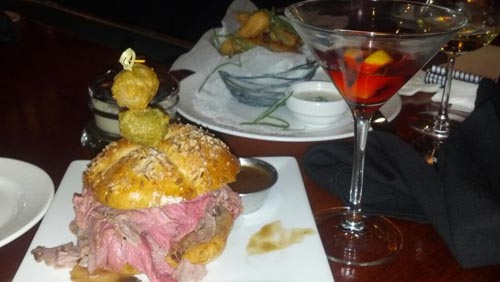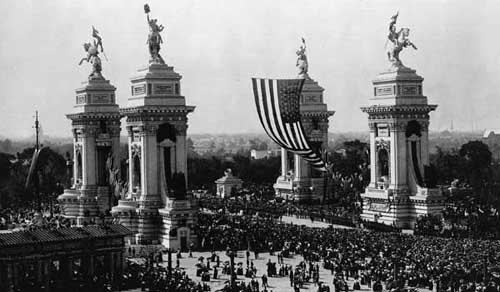
(Beef-on-weck alongside a Buffalo-tini made with Gray Goose Vodka and loganberry ice provided by Jon-no-h. Photo courtesy The Lovely Bea.)
My son drove me out to Suitland for the “pinning” ceremony yesterday morning, since I am still gimping along and needed to take the Hubrismobile into the dealer, located near his apartment. He picked me up there and we drove across the busy morning Washington to the Office of Naval Intelligence, where Nimitz OPINTEL Center commander tacked the warfare device of the Information Dominance Corps on my son’s left breast.
It was a very moving ceremony, and frankly choked me up. He rolled me back into the city when it was done, down the Suitland Parkway and past all the construction on the east side of the Anacostia where the highways are in chaos and the enormous sprawling campus of the new national security state is rising on what was the grounds of St. Elizabeth-with-a-Z Asylum for the Insane.
Not that there is any overt connection between the old institution and the new one, but I have my suspicions.
He dropped me back at the office where there was a daunting stack of papers on which to labor. Before he roared off I offered to buy him dinner to celebrate when the day was done. It was a matter of some anticipation amongst the regulars at The Amen Corner of the Willow Bar.
Tracey O’Grady had been talking about doing “Beef on Weck” sandwiches for the Friday special. The creation is a Buffalo, NY, favorite. In point of fact, some people consider the thinly sliced rare roast beef (piled high as 6 inches) on a freshly-baked kummelweck roll the best roast beef sandwich in America. Few, if any, restaurants outside the Buffalo area serve this unique regional delicacy. Or know what it is, or that matter.
It is the kummelweck roll that makes the sandwich unique, crusted with rough pretzel salt and caraway seeds. Tracey’s business partner (and mistress of all baked things) Kate Jansen did the rolls from scratch in the Willow ovens.
The beef came from a cow who was raised on grass in the Shenandoah Valley, and specially ordered this week. On the side was a basket of Willow’s magnificent fries with two dipping sauces: creamy horseradish rich brown gravy. Not a drop of catsup in sight.
It is a little sad. The beef-on-weck is a dying institution. The history of the sandwich goes back to the turn of the previous century, when Lakes cities like Buffalo and Toledo and Detroit were roaring centers of commerce.

(Crowds throng the 1901 Buffalo Pan-American Exposition.)
Buffalo was the site of the 1901 Pan American Exposition. In anticipation of the throngs of attendants, a local man named Joe Gohn purchased a small saloon that he named “Delaware House.” It was a strategic purchase- the tavern was located across the street from one of the main entrances to the Exposition. He enlarged the building to offer lodging for tourists. Delaware House was never really a hotel, but in order to sell whiskey, Joe had to have ten bedrooms and sitting rooms for prospective guests.
There were some VERY small rooms at taverns in those days.
Trolley cars let of streams of people right in front of Delaware House, and Joe decided that a roast beef sandwich washed down with icy-cold beer would be just what the crowd would need, away form the sludge sold on the Midway of the Exposition. Joe had a German baker working for him, possibly named William Wahr, who suggested adding the caraway seeds and salt to the top of the Kaiser rolls he baked as they did back home.
In Germany, this type of roll was called a kummelweck, efficiently truncated in Buffalo’s argot to “weck.”These sandwiches soon became very popular, and of course, the salt and horseradish dressing on the kummelweck helped to parch the palates of the thirsty patrons and moved a lot of beer. There ain’t so such thing as a free lunch, after all.
Beef-on-weck became standard fare in most of Buffalo’s taverns, but as Tracey notes, the standard has come down over the years. Back in the day, the bartender would carve the Steamship Round right in front of the drinkers, and Willow’s version was very much in the ancient tradition of her home town: big dill pickles and grated horseradish, and rare beef piled high on the weck rolls.
Liz-with-an-S, Katya and Jasper were holding down the business end of the bar, and we had several pals on the drinking side of the bar- Old Jim, his wife Mary, Jon-no-H, The Lovely Bea, Boats, the ISCM, my son, and some other hangers-on. It was a grand time, but there was business to be done, too.
Boats had business to do. He left DHS in disgust and is headed back to Louisiana. He was weary from dealing with the idiots appointed to inspect the Coast Guard and other elements of the fractious aggregation of loosely-associated agencies, bureaus and offices that make up the Homeland Security sprawl.
We talked at length about how he got a band to play at Coast Guard Week at the World’s Fair in New Orleans in 1984 (he schemed to use the Air Force Airmen of Note in coast guard covers and brassards to cover their chevrons) and how he got into the expert witness game on the subject of knot-tying. He had an uproarious tale about his first murder trial as an expert, and concluded that there is no forensic ability to determine who tied a knot, only if the perpetrator had been competent or not.
The buy on trial for murder was convicted, though he managed to spring himself from the notorious Angola prison farm after discovering some evidence the Police had suppressed after twelve long year.
Boats came all the way from Annapolis because he wants to launch a collaborative assault on the Jones Act.
That is going to take a minute to explain, sort of like knots. Boats has a revolutionary goal of requiring a three section-watch bill on the crews of tow-boats and other river/near shore ships. Currently, they operate on a two-section watch bill (twelve hours, rather than eight). Boats claims the long shifts make sailors loopy and cause navigational and other safety mistakes, like ramming bridges and other ships and barges. He also asserts that the sailors who work the extended hours also die young due to sleep deprivation.
The Navy has been on three-section watch since around 1776, so this is not exactly rocket science.
More on that tomorrow, when we actually get to the Jones Act.
Copyright 2012 Vic Socotra
www.vicsocotra.com
